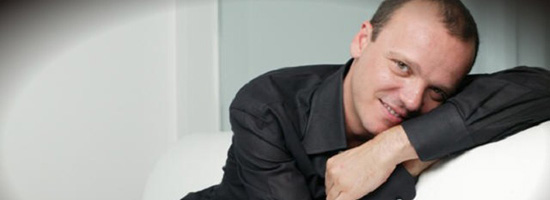
Mounting a Gala Show in Radio City
The Artist:
Gigi D’Alessio is very popular in Italy. He is also known in Brasil for having recorded “Um Coração Apaixonado", with Wanessa Camargo. The show at Radio City included guests Liza Minnelli, Paul Anka, Sylvester Stallone, Anastacia, Manhattan Transfer, Mario Biondi, Christian De Sica, Enrico Brignano, Benvenuti & Griffith, Valeria Marini, & Ivete Sangalo. His band: 2 guitars, bass, drums, percussion, piano, keyboards and a horn section, was supplemented by a small string orchestra of about 40 New York musicians. A dance troop of 12 persons was also part of the performance.
Technical Details:
The show was recorded in HD, 1080i and surround by All Mobile Video’s Crossroads OB unit for editing and transmission the following week in Italy. Richard Wirth directed the cameras. He and Lenny Laxer of AMV managed the technical aspects of the production. Twelve Sony HD1000 or HD1500 cameras were used, including two jibs, two fixed cameras, a remote controlled track-mounted robotic camera on a crane, a hand-held camera and a steadicam. The backdrop was an enormous (25m x 31m) HD LED screen that was provided by Radio City. This screen was fed with live images from the cameras as well as prerecorded scenes and images, all sequenced and timed to the show and controlled by a computer. The “line cut” and all of the cameras and images were individually recorded. Over one hundred seventy two audio channels were recorded, including the microphones used to capture the ambience and microphones mounted on the moving cameras. All of these microphones were mixed live as well as recorded individually in Protools for remixing in postproduction. Microphones and effect groups were created and organized by instrument type which were then sent to the Studer Vista 8 mixing desk in the OB UNIT. Certain key performance mics, like the lead vocal and certain soloists were sent individually. All audio routing in the OB unit originated in the Studer Vista 8.
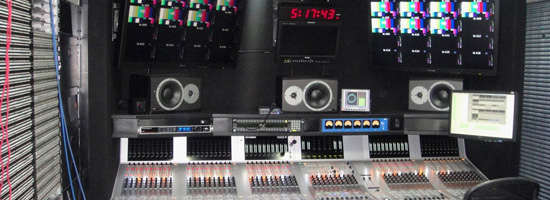
Because of time and budget constraints we never had a full dress rehearsal. Richard, our director used a series of coverage zones for the cameras, similar to a multi-camera film shoot, so that each camera had a specific area to concentrate on. One camera covered the star, Gigi at all times. Other cameras covered the dance routines and guest artists. This ensured that all aspects of the performance could be video taped for use in post-production, if necessary. Stage entrances were pre-planned so that each guest could be shown entering and leaving the stage. Occasionally, these were altered at the last minute which caused some consternation in the OB unit. However, clear communication and fast thinking always saved the shots.
Intercommunications:
The intercommunications system was an RTS/Telex Adams digital matrix system with 144 inputs and outputs. In the theater, 12 channels of wireless intercommunication were used in addition to 26 wired stations and all the camera intercoms. All key personnel in the OB unit had 32 channel digital key panels.
Setting Up
The show was scheduled to start at 19:30 on Monday, 14 Feb. Set up started two days earlier at 08:00. We were allotted 10 hours on Saturday to install all of the equipment. On Sunday we had another 10 hours for rehearsals of specific camera angles for dance routines and specific timing issues as well as some fine-tuning of the equipment.
The main lighting array was installed first. The PA system was installed next. It was an i-Series line array, provided by Clair. The house audio desk was a Protools Venue. The monitor audio desks were Digico SD8’s. Protools HD was used to record the show. Word clock was derived from the video master clock on the mobile unit, which also provided time code. As the show was for broadcast in Italy, all of the video and time code references were PAL, based on 25 frames/second. The audio tracks were recorded at 48K/24 bit.
The client provided us with a wish list, which we translated (sometimes literally from Italian into English) into our technical requirements. Intercommunications systems are always essential: often overlooked, until there is a problem, but if nobody can communicate, the show will NOT “go on”. In this case, someone would usually say or write, for example, that “Roberto” needed to speak with “Julio”, “Annette” and “Richard”. We would have to determine who these people were, what they did and what language they spoke. This in and of itself was a challenge as there was no complete crew list of both technical and production people and nobody wore nametags. We would then create the necessary channel in the matrix software and label it accordingly. Modern intercommunications systems are both software and hardware based, so not only does the computer need to be programmed correctly, but also the hardware needs to be adjusted and balanced for optimum performance. In a live event, there is only one chance to capture the moment, so correct equipment preparation is of the utmost importance.
The sound reinforcement crew and the artist determined all the microphone selections and positions. All wireless frequency allocation was determined on site by using “Shure Wireless Workbench™” software. The microphones, IFB’s, and wireless intercoms were coordinated to provide the most reliable performance without radio frequency interference. As there were 38 wireless mics, 24 wireless monitors and 12 channels of wireless intercom, as well as literally hundreds of walkie-talkies, this coordination was critical to the success of the show.
The intercommunications system had to accommodate both English and Italian speakers, sometimes sharing the same channels. Stage managers needed to speak with the artists, the Italian production staff and the American technical staff.
The television and camera crew all spoke English, as did the director. However, the producer, lighting designer, choreographer and musical director were all Italian. A great deal of patience was needed (as well as hand gestures). One interesting challenge was to keep the critical technical conversations in English separate from the creative/production conversations in Italian. All departments were assigned their own channels for communication; lighting, PA, TV audio, house coordination, video, camera, engineering and two channels for production.
A note regarding labels and identification: as the technical staff was mostly American and the production staff was mostly Italian all of the equipment needed to be labeled in both languages. This was especially critical for communications. Only a very few people were fluent in both English and Italian.
Video Tape
All cameras and images were recorded individually to videotape. All machines were fed with timecode referenced to time of day. Every machine received a stereo mix of the program. All of the machines recording moveable cameras were fed with the particular camera’s associated microfone, copied to two channels. Certain image sequences were also recorded to EVS video hard disk systems in order to create playlists that were later recorded to VTR’s. Additionally, several HD camcorders were used to capture ambience from backstage, the audience and on the street.
Videotape ran continuously. All recordings were started at different times, so that overlaps could be recorded in EVS hard disk recorders and then transferred to videotape with the original timecode. All tapes were 1 hour in length. With a total of 16 recorders it would be impossible to change all tapes at once and keep a continuous recording of every source. So this system of overlaps was implemented. Using longer videotapes is not generally advisable as longer tapes are thinner and more subject to damage.
Multitrack Audio
Every input source on stage was captured separately and recorded to a Protools HD system. Most of the signals were derived from the FOH audio desk. Ambience and audience microfones were recorded directly to the Protools HD system, using separate microfone preamps.
Here is a list of all of the microfones used in recording:
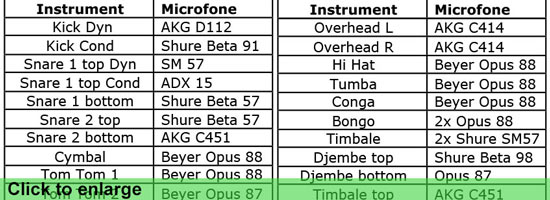

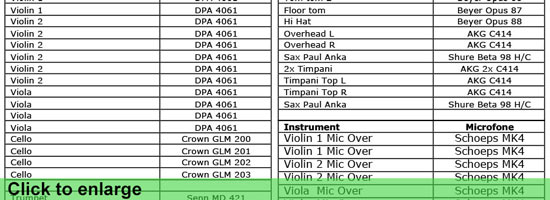
The antennas, receivers and transmitters for the wireless microphones and in-ears were located next to the monitor audio desk, backstage left. Most of the interface between the PA system and the OB unit was located here as well. To ensure better RF separation we placed the wireless intercom on the opposite side of the backstage area. This allowed for greater flexibility in focusing the antennas for better coverage and better access to the equipment for programming and maintenance.
Every frequency of every channel had to be changed to fit into the available spectrum.
Very often, on larger shows frequency coordination is handled in advance: every major venue in the USA has been “mapped” to show what spectra are available. It is therefore merely a matter of cross checking the available frequencies against what your equipment is capable of. All that is required is a list of the available gear.
Intermodulation and illegal frequency and power use is fairly common, so an RF spectrum analyzer is used to confirm the available space. The equipment is then fine adjusted on site. In the case of this show, all frequency coordination and adjustment was done on site, which took a considerable amount of time.
Radio City Music Hall is a “union” house. The entire technical crew are members of
IATSE, the International Association of Stage and Theatrical Employees. The rules are fairly rigid, but the crew at Radio City are extremely competent, helpful and generally friendly. It can be intimidating to work at such a famous facility, but with patience and respect to the regulations of the theatre, Radio City is one of the best places in the world to work. The attention to detail and personal safety is both impressive and reassuring. For example, when the lighting grid is about to be lowered, a horn sounds and ALL work stops. This reduces confusion, allows the appropriate personnel to work quickly and efficiently and prevents injuries due to falling objects or heavy cables.
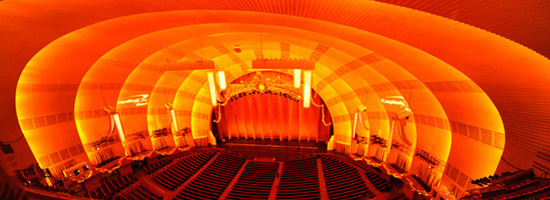
Radio City is renowned for its “stagecraft” Every part of the stage is on a hydraulic lift, so that entire sets can appear from and disappear into the floor, as if by magic.
Large objects, even trucks and elephants can be rolled, lifted into the ceiling, or flown across the stage. Of course our show did not include any flying elephants, but they would have been happily accommodated for, had they been needed for the production.
However, the capabilities of the house meant that we were able to build a very large show in about 16 hours, with an orchestra, band, dancers, special guests, complicated lighting and scenery cues, a large PA system, all of which had to be integrated with the High Definition OB unit with the Grass Valley Kalypso, Studer Vista 8, intercom system, and HD television cameras. Disassembling the show was also made easier by having such capabilities.
All of the necessary configurations were saved in all of the various mixing desks and recalled as each different pieces of music required. Lighting cues and video screen presentations were also preset. Camera shots were mostly handled manually, with a few presets on particular cameras for finding focus when the lights were out. Video settings for each camera were preset and then adjusted manually as required by particular shots. Cameras had to be maintained in correct adjustment constantly, as each camera was being recorded individually at all times.
The Show
The show was presented as one continuous performance without an intermission. Italian comedian Enrico Brignano provided some routines between musical segments. With all the performers and comedic intervals the entire show lasted about three hours, including the encores. The show was recorded with extensive notes and then edited in Italy for presentation the following week. The presentation was also to be made available for DVD release in Europe.
Daniel Littwin , director New York Digital.
contact: daniel.nydigital@gmail.com
São Paulo, Brazil
